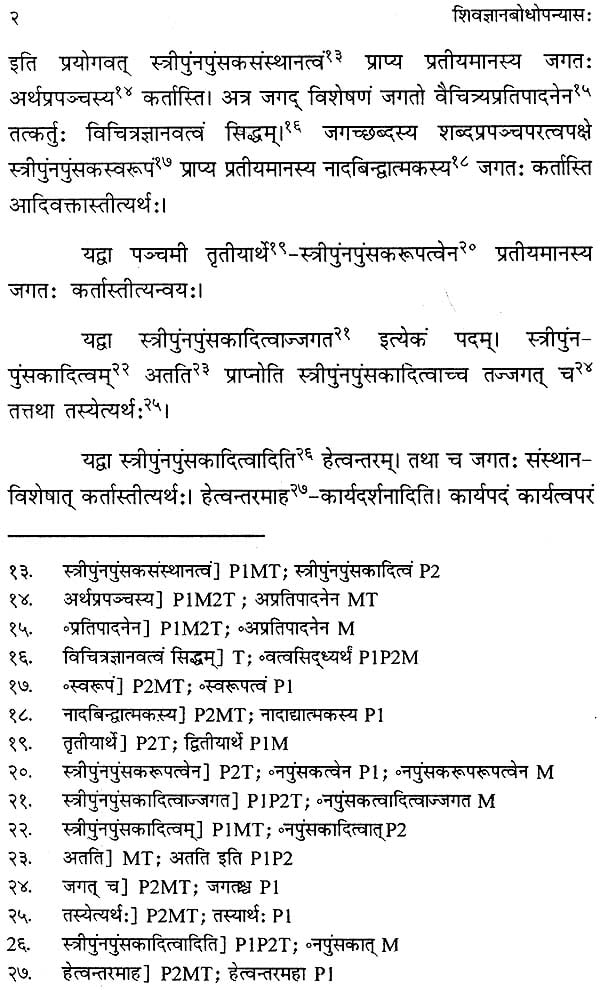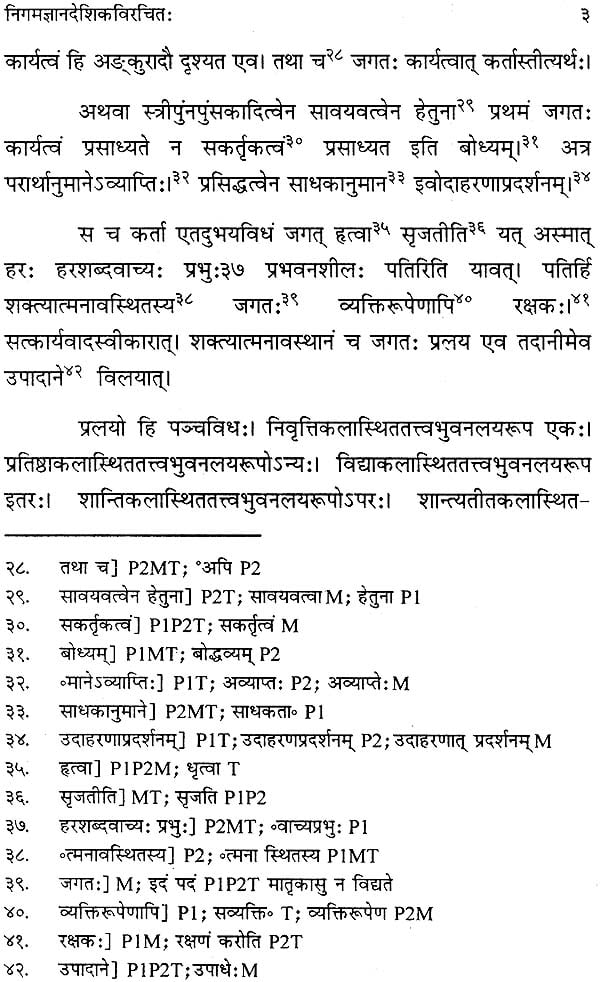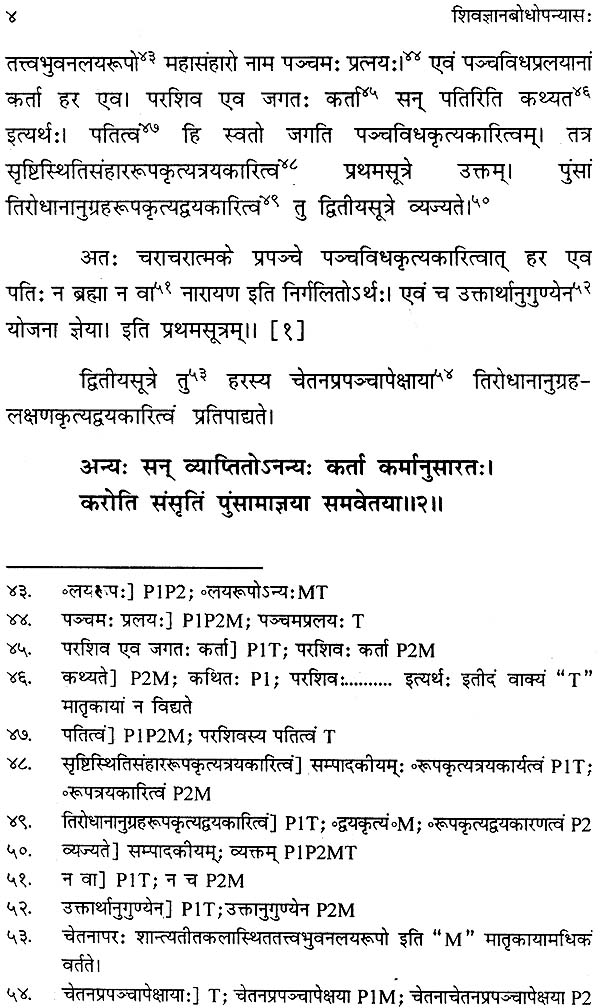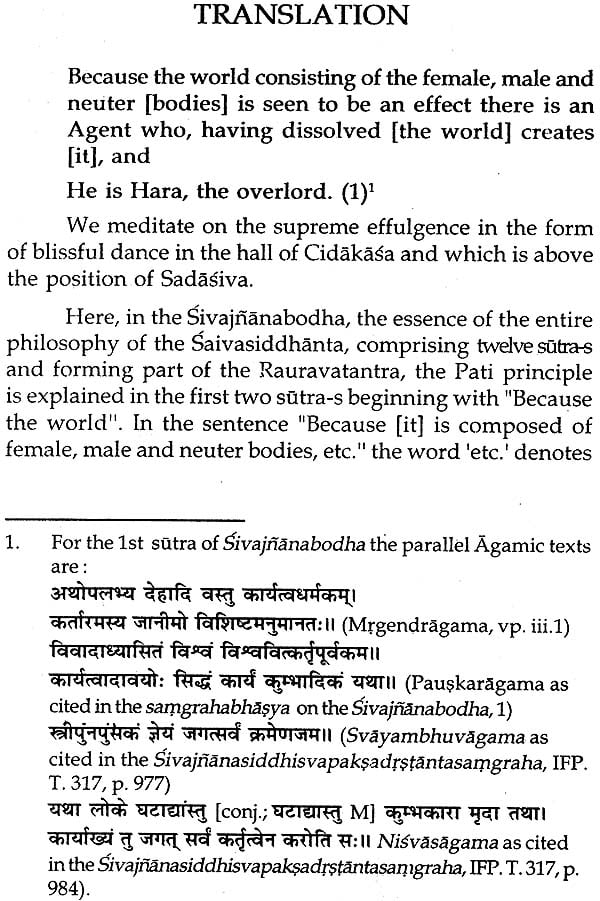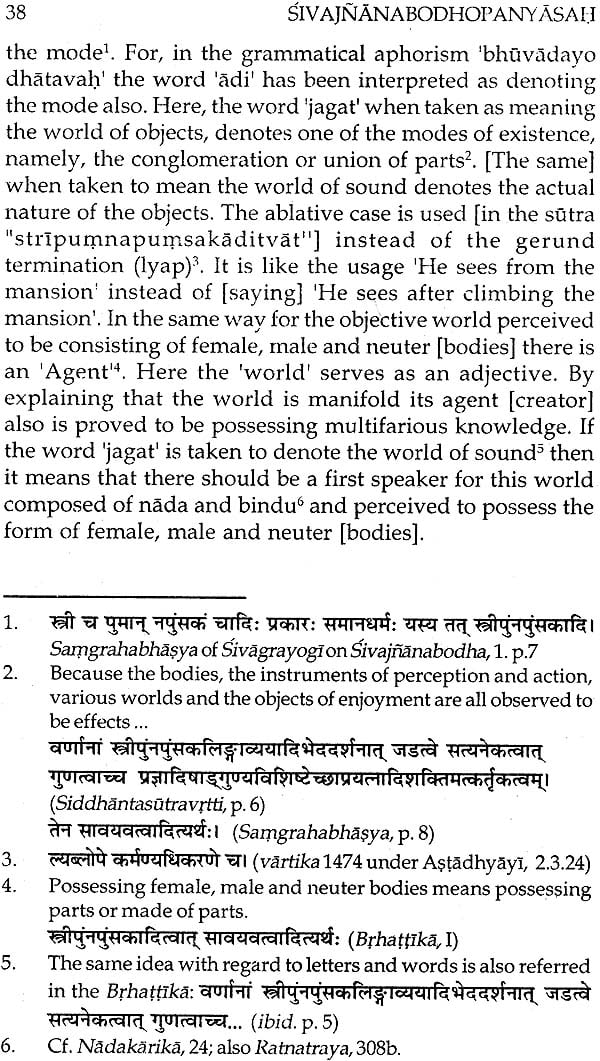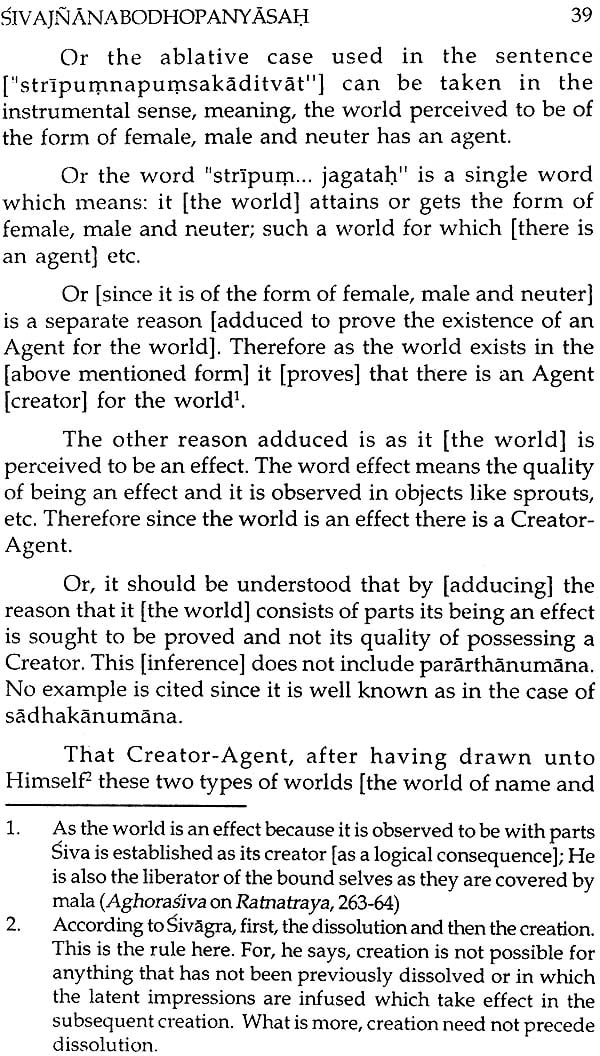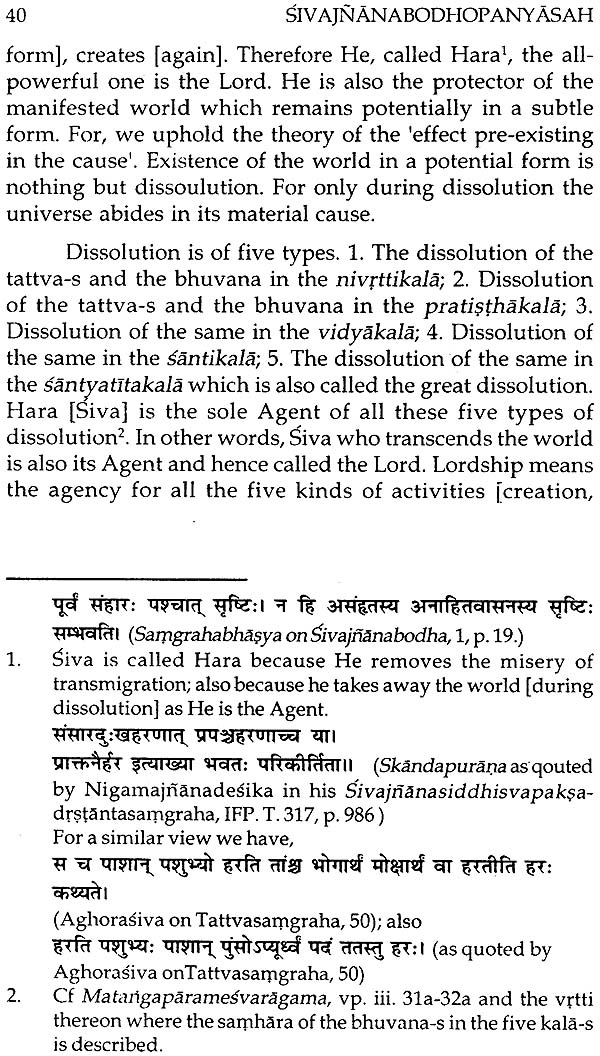
शिवज्ञानबोधोपन्यास: Siva Jnana Bodha Upanyasa - A Commentary on the Sivajanabodha by Nigamajnanadesika
Book Specification
| Item Code: | NZK790 |
| Author: | टी. गणेशन् (T. Ganeshan) |
| Publisher: | Rashtriya Sanskrit Sansthan, Janakpuri |
| Language: | Sanskrit Text With English Translation |
| ISBN: | 9788186111277 |
| Pages: | 104 |
| Cover: | Hardcover |
| Other Details | 8.5 inch X 5.5 inch |
| Weight | 250 gm |
Book Description
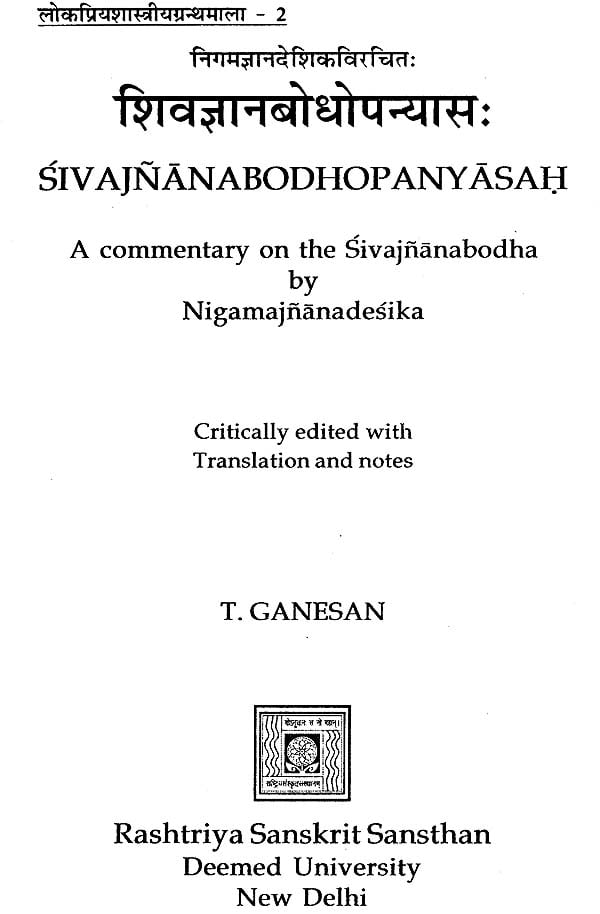
Sivajnanabodha has come to stay as the basic text of the Saivasiddhanta system that is practised now in Tamilnadu. Though there are independent saiva texts in Tamil such as Nanamirtam which were written in the 12th century (before Meykatar) that expound the doctrines of the Saivagama-s the Saivasiddhenta school of religion and philosophy that is now in vogue can be called the 5ivajrianabodha school. For, the entire range of texts is based :)11 the Sivajnanabodha (in Tamil) which is considered to have been composed by Meykantar in the middle of the 12 th century, A.D. According to tradition and as expressed by all the commentators Meykatar has given the Tamil version from the Sanskrit original which, again, is held to be part of the Rauravagama.
As such the Sanskrit text which has quite a few important commentaries (the earliest one that has come down to us dates from the 15th century) has not been fully studied and much less interpreted. This is the first time that a critical edition of a hitherto unpublished commentary on sivajnanabodha is being published. The commentator Nigamajnanadesika is an important author of the 16th century and he has contributed a lot for the propagation of saivasiddhanta and for the elucidation of philosophical Points. His only other work that has been critically edited and published with a French translation is the Saivagamaparibhasamanjari (Publications de l'Institut Francais l'Indologie, n- 60, 1977). One may profitably refer to the above publication for a list of his Sanskrit works (as he has composed texts in Tamil as well) and for a brief discussion bout his date and spiritual lineage.
Another luminary in the firmament of Saivasiddhanta is Sivagrayogin who is a contemporary of Nigamajnana; he is relatively well-known through his commentaries (Laghutika, Samgrahabhasya and Brhattika) on the Sivajnanabodha and a manual on the saiva monastic rites (Saivasamnyasapaddhati). But Nigamajnana is not so well known as most of his works have not been published. The present critical edition and translation of the Saivajnanabodhopanyasa will, I hope, fulfill such a need in a small way by introducing him to the scholarly world. If his other works are also taken for critical edition based on the manuscripts of which many are housed in the collections of the French Institute, Pondicherry and elsewhere it will certainly help in tracing the History and Development of Saivasiddhanta in Tamilnadu in the late medieval period (approximately from 1500-1800 A.D.)
Now it is my duty to convey my sincere thanks to all those who have helped me in one way or the other for the completion of this work. It was late lamented Sri. V. Varadachari who suggested me to take up some of the hitherto unpublished Saivasiddhanta texts from the manuscript collections of the French Institute for critically editing. Sri R Subramanian who passed away a few years ago was more than a friend to me and I have gained much from discussing with him. The late Sri. K. Ramachandra Sarma who worked as senior pandit in the Adyar Library and Research Centre, Chennai for many decades has taught me a lot and encouraged me much in my researches. I express my respects to their memory. My humble respects to the Gurumahasannidhanam of Thiruvavaduthurai Math, Thiruvavaduthurai for his blessings and encouragements. Sri. P.T.G. Sampatkumar who is now at the Rashtriya Sanskrit Vidyapeetha, Tirupati has helped me by collating and reading through the Telugu manuscript of the text from Thanjavur and I express my Sincere thanks to him. I also thank the authorities of the Tanjore Maharaja Serfoji's Sarasvati Mahal Library, Thanjavur and the Government Oriental Manuscripts Library, Chennai for allowing me access to the manuscripts.
This work is part of my research theme" History of Saivasiddhanta in Tamilnadu" at the french Institute, Pondicherry. I also sincerely thank Sri. Kutumba Sastri, Vice-Chancellor, Rashtriya Samskrit Samsthan, New Delhi for having accepted this text for publication in the series of the Rashtriya Samskrit Samsthan. I sincerely thank Or M. Narasimhachari, retired professor of Vaishnavism, University of Madras for having gone through the text of the translation and for his valuable suggestions and corrections.
I also sincerely thank Prof. Radhavallabh Tripathi, the present Vice-Chancellor, Rashtriya Sanskrit Sans than, New Delhi for having published this book in its series. Finally I express my gratitude to all those who wished to see that this text is published soon.
Sivajnanabodha is the text that imparts (bodha) the knowledge (jnana) of Siva, the supreme and highest Reality. Therefore by studying the text and practising the required spiritual disciplines [as enunciated in the text] one is supposed to attain to that Reality. Thus the text is both a philosophical treatise and a guide for spiritual discipline. The text consists of 12 verses composed in anustubh metre. According to most of the commentators this text is part of the Rauravagama which is one of the 28 mulagama- s of the Saivasiddhanta system. But the published text (in 3 volumes) of this Agama does not contain this text. Apart from the Saivasiddhanta theologians we have the evidence of Appeyedikuita (circa. 16th century) who cites in his commentary called Sivarkamanidipika on the Srikanthabhasya on the Brahmasutra II.i.16 the second sutra of the Sivajnanabodha and calls it Agama. The third volume of the Rauravagama in its 58th chapter refers to a Sivajnanabodhasastra to be taught to the disciple as part of jnanadiksa.
To briefly outline the points discussed in this text in the form of a free translation: Siva is the supreme Creator, Protector and Destroyer of the universe which is an effect; He absorbs the already existing universe and then creates it and hence this universe has Siva as its source. Siva performs all His acts-creation, etc.-in close association with His Supreme power-Sakti which is non different from Him and does not exist separate from Him.
A conscious agent, the individual self, exists separately from the body-mind complex and has the continuous experience in all the states-waking, dream, deep sleep and beyond.
The self in close association with the internal organ, the mind, experiences five states of consciousness; its innate power of knowledge and action is very much restricted by mala-the impurity-which exists in association with the self since beginning less time.
Siva is the supreme Agent, the driving force behind all the acts of the self. On that account He neither undergoes any change nor experiences pleasure nor pain. For, He performs all acts just as the magnet activates the iron kept in its proximity without itself getting affected in any way. Siva is neither perceivable objectively by the self (through the sense-organs) nor completely imperceptible. He is to be realised as different from both in one's own inner self.
The material world which is inert does not shine in the presence of Siva who is supreme consciousness; nor does Siva 'know' it objectively as He is all-knowing and omnipresent. Therefore only the individual self knows both Siva and the world of matter.
The self overpowered by the sense organs completely forgets its real nature. The preceptor (Guru) by appropriate spiritual instructions frees it from the clutches of sense organs and thereby makes it realise its actual nature which is non-difference from Siva.
Realising Siva at the highest level of its innermost consciousness and abandoning its association with the fleeting world of matter the self meditates on the holy pancaksaramantra.
Such a realised self fully conscious of his union with Siva and existing completely under Siva's control becomes free from mala, maya and other impurities.
Just as the self makes the eyes see so also Siva makes the self see; in other words, the self perceives by the help of Siva. Therefore the self should be devoted to Siva, its supreme benefactor.
To attain to the state of liberation the self may resort to holy men, wear their attire and serve in the temples of Siva.
Let us now take up for a brief examination some of the important philosophical ideas expounded in the text of the Sivajnanabodha. In that we will study the text as it is without much recourse to its commentaries. The text mainly discusses the Lord (Pati=Siva), the individual self (Pasu) and the different means for the self to attain Siva. To begin with, the concept of Pati-the Lord-may be studied as under:
The existence of a supreme and a unique cause that creates, sustains and dissolves the material world is established on the basis of the inferential argument. In the Nyaya System this type of independent inferential argument is adopted to establish the existence of a supreme god whereas in the Vedanta system it is done on the basis of the revealed text namely the Upanisads. In Some of the saivagama texts such as the Pauskara. Parakhya Svyambhuva and the Mrgendra inferential argument is used to prove the existence of pati. The syllogism goes thus: As the world consisting of living creatures that are divided into female and male as well as inert object is observed to be an effect it should have an agent (Karta) who has created it; and that agent is none but Siva. For, that which is an effect and made of parts should have a cause. Secondly Siva does not bring about the world from nothing. He creates that which He had already dissolved unto Himself. Therefore he, who is the destroyer, in other words, the dissolver of the previously existing universe is its creator. It is also established that except siva no other god is capable of performing the three acts of creation, sustenance and dissolution. In this sutra the idea of dividing the living creatures into female and male entities may be noticed.

